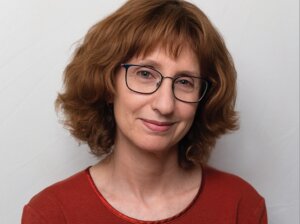Onetime Lubavitcher Creates New Life Out of Whole Cloth
On a recent Sunday evening at the height of New York’s Fashion Week, the Cafe Deville was bustling. Backstage, beneath the downtown bistro’s dining room, designer Levi Okunov’s latest line of coats hung from a set of racks. A hairdresser and a makeup artist were busy doing up the models according to this year’s theme: the courtesan. Upstairs, the crowd was eager for the start of the show.
At age 20, Okunov is one of the fashion scene’s hot young stars. Although he has had no formal training aside from a single course he took at the Fashion Institute of Technology, his cutting-edge women’s coats have earned him some serious attention.
The biggest surprise, though, is that Okunov was born and raised in the Lubavitch community in Crown Heights, Brooklyn, and speaks Yiddish fluently. “My father is Russian, my mother Israeli, and I have 12 brothers and sisters,” Okunov told the Forverts. “And we all speak only Yiddish at home.”
At 15, Okunov discovered a sewing machine in a friend’s basement and was entranced. He turned to his aunt, Zlata Okunov — a seamstress well known in New York’s ultra-Orthodox community for her wedding designs — and asked her to teach him the trade. Last year, at his first fashion show, he showcased a line of colorful raincoats filled with down. That same week, Women’s Wear Daily included him in a list of “new wave of designers”; the Web site New York Cool has called him one of today’s “fashion gurus.”
The coats in this year’s show were reversible: monochromatic on one side, and custom painted by designer Sascha Ascher on the other. “If not for Ascher’s splashes of color, the garments wouldn’t have been so compellingly attractive,” remarked Okunov’s friend and assistant, Sion Mitrani.
What’s most notable about Okunov and his entourage is that most of those quietly helping him behind the scenes were, like the designer himself, raised in one of New York’s ultra-Orthodox neighborhoods. One such acolyte, a bearded business consultant in his early 40s named Yitschak Schoenfeld, explained what drew him to Okunov: “He’s able to create this persona ‘out of whole cloth,’ so to speak. It’s like Madonna re-creating herself again and again. The other thing is, he has this unique capacity to embrace you even before you have a chance to say anything. All of this makes him highly marketable.”
Schoenfeld was hardly the only Orthodox Jew at the show. Milling about among the fashionistas — models, photographers, journalists and buyers — were a number of men wearing either yarmulkes or the baseball caps favored by Orthodox trying to be inconspicuous. When asked why they had come to a show in which the models were not dressed modestly, all of them responded: “Because of Levi.”
Schoenfeld explained that most of those attendees were part of the so-called “alternative community” — a loosely knit group made up mostly of men between 20 and 45 years old who were raised in ultra-Orthodox communities but now find themselves on the periphery of the ultra-Orthodox society. Some are still observant; others have lapsed. “We’re not talking about Hasidic kids at risk, like the ones doing drugs,” Schoenfeld explained. “These men are older. They may be divorced or going through a divorce, or never married, or are having problems buying into the belief system.”
The group has been meeting regularly since the mid-1990s, and now it rents an apartment in Boro Park expressly for that purpose. Tuesday nights are set aside for Talmud class; Thursday nights, for chulent and shmoozing. Anywhere between five and 20 people show up on a given night, and most hang around till 2 a.m.
Members of the group who attended the show praised Levi’s respectful attitude toward the religious community in which he was raised. “You know, he still lays tefillin!” said one, requesting that his name not appear in print. Another related that a week before last year’s show, Levi invited a well-respected Lubavitch rabbi to his showroom to study Torah with him. “The models kept coming in, so the rabbi made sure to keep the door open,” he added, referring to the law requiring that a door remain open when men and women are in a room together.
Okunov said that even his mother has been cautiously supportive of his career, and she has commented that had the show had a mechitsa (wall separating the men from the women), she might have attended. “This is probably what Hashem [God] wants from him” she said.
Technically, the show was flawed. The lighting was uneven, and the runway, which wasn’t set up until an hour after the designated time, was too low for audience members to get a good view. But the crowd didn’t seem to mind. All the models were greeted with enthusiastic applause as they walked along the runway.
Reporters from the New York Times, People and Vogue were in the audience, as well as buyers from Bergdorf Goodman and Neiman Marcus. Another guest was Michael Gallagher, whose comprehensive archive of fashion magazines gets orders from such fashion industry A-listers as Marc Jacobs and Donna Karan. After Okunov’s show, Gallagher remarked: “Some people I know came from other shows just to see him. They see there’s something fresh here.”
This article is adapted from a version that appeared in the Forverts.

















